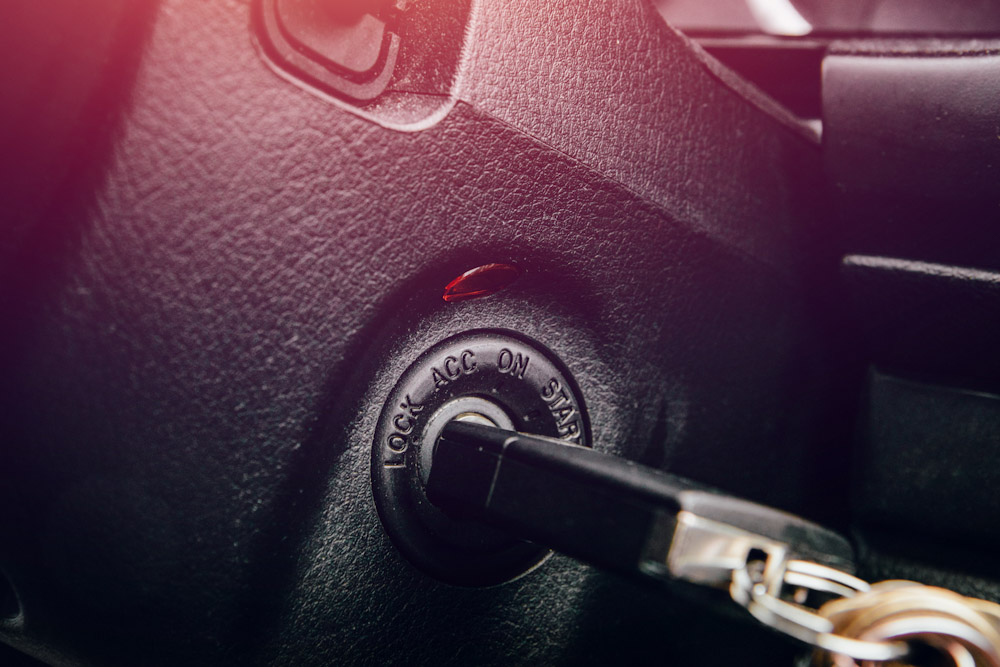
Car enthusiasts love putting the key into the ignition and hearing the engine start up and roar. After a couple of quick revs, they’re off to the races. But in that split second that elapses as the key is turned, a lot is happening under the hood. The vehicle system tasked with efficient operation during this split second of time is the ignition system, and it has a lot of important duties and responsibilities. Here are some ignition system basics brought to you by your auto repair experts at Master Muffler Utah and Idaho.
Components of a Conventional Ignition System
There are different types of ignition systems for different engines. Electric engines have a slightly different infrastructure than do combustion engines and older vehicles may have slightly different componentry than newer vehicles. However, since most cars on the road today own combustion engines, we will be focusing on a corresponding system. A conventional ignition system has 5 main parts which include:
Battery – The battery provides the electric current that ultimately starts the engine.
Ignition Switch – Also known as a starter, this component activates the main electrical components of a vehicle.
Ignition Coil – This component is a conduction coil that magnifies the battery’s voltage to the thousands of volts needed to create an electric spark.
Distributor – The distributor is tasked with distributing sparks to each of the engine’s spark plugs.
Spark Plugs – Spark plugs deliver the channeled spark to the fuel-air mixture in each engine cylinder, ultimately providing the means by which the engine can produce power.
Basically, the process is as follows:
- The key activates the ignition switch.
- The battery provides a current which travels to the ignition coil.
- The ignition coil magnifies this current.
- A spark is created from the generated electrical energy.
- The spark is distributed to each of the spark plugs by the distributor.
- Each spark plug ignites the fuel inside the cylinders of the engine.
- The explosions created by fuel ignition create the power that moves the vehicle forward.
Now, amazingly, once the engine has started, the above process happens at a very rapid rate— approximates 18,000 times per minute at 90 miles per hour. We have the ignition system to thank for getting things going.
Ignition System Repairs
If your vehicle is having trouble starting after you turn the key, a number of different issues could be responsible. The most common, however, are bad batteries, alternators, or spark plugs.
When it comes to batteries, internal components wear out over time and become less effective. It is recommended that a car owner replaces the battery every 3-5 years depending on use. This will help ensure that it doesn’t entirely give out.
Alternators are a type of electric generator within a vehicle that charges the battery and helps power the electrical system while the engine is running. If the alternator is not working properly, the battery will not be properly charged while the car is running. This will ultimately result in a dead battery.
If your vehicle is hard-starting, idling, experiencing reduced fuel economy, making strange noises, or losing power, the spark plugs may need to be replaced. Typically, a car can drive 80,000 miles or so before the spark plugs start causing issues.
Idaho and Utah’s Best Auto Repair
Within our operation, we currently have 2 Idaho locations and 15 Utah locations dedicated to serving those in each respective community. Our mission is to deliver best-in-class auto care affordably and painlessly. If you have an auto repair need, whether it be a new battery, alternator, spark plugs or whatever else, our experienced Idaho and Utah mechanics will make sure everything is addressed thoroughly and professionally. With Master Muffler, you will surely find the help you need.
Call or visit us today.
Related Posts
When you think about car maintenance, you probably focus on oil changes, tire rotations, and maybe even brake pad replacement. But what about your brake fluid? If you’ve ever wondered, “What does brake fluid do?” or “Why is brake fluid important?”, you’re not alone. Brake fluid might not be the most talked-about part of [...]
Is that high-pitched squeal from your brakes driving you—and everyone else—crazy? Don’t ignore it. Squeaky brakes aren’t just annoying, they’re your car’s way of saying something needs attention. Whether you're cruising through Salt Lake City or winding up Idaho’s mountain passes, here’s what’s likely going on, how you can fix it, and when it [...]
Whether you’re cruising down I-15 toward Zion, exploring the scenic routes of Eastern Oregon, or heading north to catch the Tetons in Idaho, a smooth summer road trip starts with smart car maintenance. Before you pack the snacks and load up the playlist, it’s worth taking the time to make sure your vehicle is [...]





